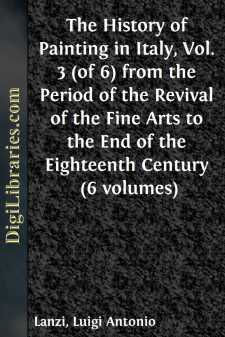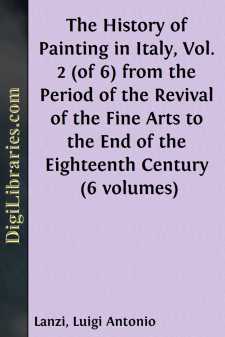Categories
- Antiques & Collectibles 13
- Architecture 36
- Art 48
- Bibles 22
- Biography & Autobiography 813
- Body, Mind & Spirit 142
- Business & Economics 28
- Children's Books 15
- Children's Fiction 12
- Computers 4
- Cooking 94
- Crafts & Hobbies 4
- Drama 346
- Education 46
- Family & Relationships 57
- Fiction 11828
- Games 19
- Gardening 17
- Health & Fitness 34
- History 1377
- House & Home 1
- Humor 147
- Juvenile Fiction 1873
- Juvenile Nonfiction 202
- Language Arts & Disciplines 88
- Law 16
- Literary Collections 686
- Literary Criticism 179
- Mathematics 13
- Medical 41
- Music 40
- Nature 179
- Non-Classifiable 1768
- Performing Arts 7
- Periodicals 1453
- Philosophy 64
- Photography 2
- Poetry 896
- Political Science 203
- Psychology 42
- Reference 154
- Religion 513
- Science 126
- Self-Help 84
- Social Science 81
- Sports & Recreation 34
- Study Aids 3
- Technology & Engineering 59
- Transportation 23
- Travel 463
- True Crime 29
The History of Painting in Italy, Vol. 3 (of 6) from the Period of the Revival of the Fine Arts to the End of the Eighteenth Century (6 volumes)
Description:
Excerpt
VENETIAN SCHOOL.
This School would have required no farther illustration from any other pen, had Signor Antonio Zanetti, in his highly esteemed work upon Venetian Painting, included a more ample consideration of the artists of the state, instead of confining his attention wholly to those, whose productions, ornamenting the churches and other public places, had all been completed in the city of Venice alone. He has, nevertheless, rendered distinguished service to any one ambitious of succeeding him, and of extending the same subject beyond these narrower limits; since he has observed the most lucid order in the arrangement of epochs, in the description of styles, in estimating the merits of various painters, and thus ascertaining the particular rank as well as the age belonging to each. Those artists then, whom he has omitted to commemorate, may be easily reduced under one or other of the divisions pointed out by him, and the whole history enlarged upon the plan which he first laid down.
In cultivating an acquaintance with these additional names, the memorials collected by Vasari; afterwards, on a more extensive scale, by the Cavaliere Ridolfi, in his Lives of the Venetian Painters; and by Boschini, in the Miniere della Pittura, in the Carta del Navegar Pittoresco, and in other works: materials drawn from all parts of the Venetian stateâwill be of signal advantage to us. No one, it is hoped, will feel displeased at the introduction of the name of Vasari, against whom the historians of the Venetian School were louder in their complaints than even those of the Roman, the Siennese, and the Neapolitan Schools; all whose causes of difference I have elsewhere recounted, adding to them, whenever I found them admissible, my own refutations. These it would be needless now to repeat, in reply to the Venetian writers. I shall merely observe that Vasari bestowed very ample commendations upon the Venetian professors, in different parts of his history, and more particularly in the lives of Carpaccio, of Liberale, and of Pordenone. Let me add that if he was occasionally betrayed into errors, either from want of more correct information, or from a degree of jealousy or spirit of patriotic rivalry, which probably may have secretly influenced him in his opinions, it will be no difficult task in the present enlightened period, to substitute the real names, more exact accounts, and more impartial examinations of the earlier professors of the school.
In respect to the more modern, up to whose period he did not reach, I possess historical matter, which, if not very copious, is certainly less scanty than such as relates to many of the other Schools of Italy. Besides Ridolfi, Boschini, and Zanetti, it includes the historians of the particular cities, the same from whom Orlandi selected his various notices of artists; and among whom none is to be preferred to Signor Zamboni for the fulness and authenticity of his materials, in his work, entitled Fabbriche di Brescia. I am, moreover, in possession of several authors who have distinctly treated of the lives, or published other accounts of those who flourished in their own cities;âsuch as the Commendatore del Pozzo, in his notice of the Veronese, Count Tassi of those of Bergamo, and Signor Verci of the Bassanese artists....




